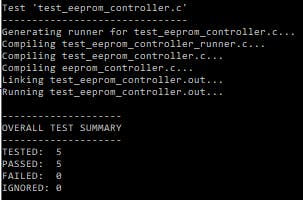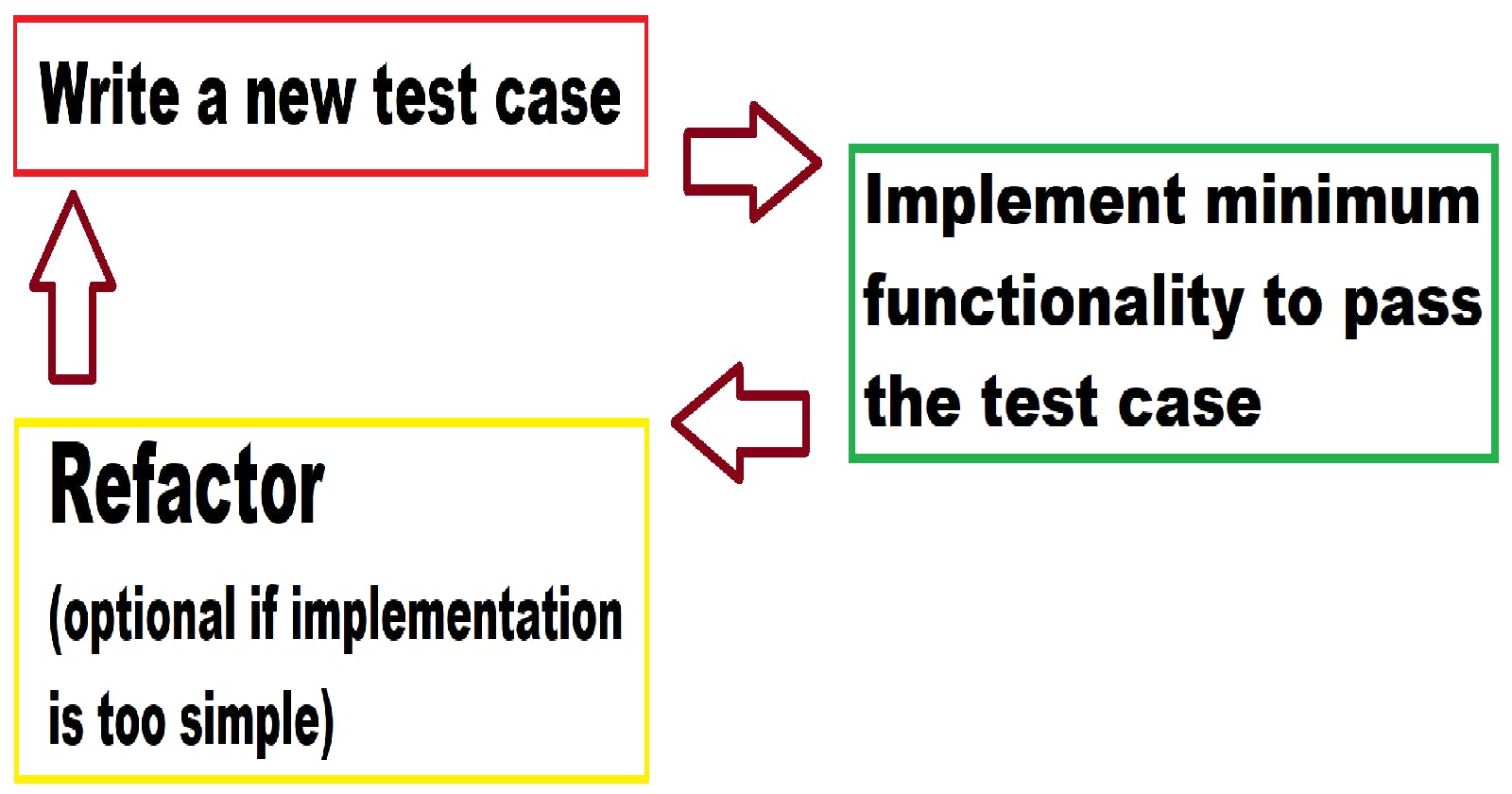This post is an extension of "TDD - You can write code without actual hardware (Part II)". Previously, eeprom_controller.c includes the read-byte function and write-byte function. Let's start to add a multiple write-byte test and a multiple read-byte test in test_eeprom_controller.c.
//test_eeprom_controller.c
void test_eeprom_controller_read_buffer(void)
{
uint16_t i;
uint8_t r_buffer[EEPROM_SIZE];
TEST_ASSERT_EQUAL(true, eeprom_read_buffer(0, &r_buffer[0], EEPROM_SIZE));
for(i = 0; i < EEPROM_SIZE; i++)
{
TEST_ASSERT_EQUAL(0xFF, r_buffer[i]);
}
}
After setup, EEPROM data is all set to 0xFF. eeprom_read_buffer function's first parameter is the start address and the second parameter is a pointer of read data and the third parameter is the length of read data. Let's write production code to pass this test.
//eeprom_controller.h
bool eeprom_read_buffer(uint32_t address, uint8_t* r_data, uint16_t length);
//eeprom_controller.c
bool eeprom_read_buffer(uint32_t address, uint8_t* r_data, uint16_t length)
{
bool op_status = false;
flash_read(address, r_data, length);
op_status = true;
return op_status;
}
To avoid the array's out-of-boundary issue, a parameter check needs to be added. A first test case is when the address is greater than EEPROM_SIZE assuming the EEPROM address starts at 0. The second test case is when r_data is NULL(0). Lastly, address + length is out-of-boundary.
//test_eeprom_controller.c
void test_eeprom_controller_read_buffer(void)
{
uint16_t i;
uint8_t r_buffer[EEPROM_SIZE];
//input range sanity test
TEST_ASSERT_EQUAL(false, eeprom_read_buffer(EEPROM_SIZE, &r_buffer[0], EEPROM_SIZE));
TEST_ASSERT_EQUAL(false, eeprom_read_buffer(1, &r_buffer[0], EEPROM_SIZE));
TEST_ASSERT_EQUAL(false, eeprom_read_buffer(0, &r_buffer[0], EEPROM_SIZE+1));
TEST_ASSERT_EQUAL(false, eeprom_read_buffer(0, NULL, EEPROM_SIZE));
TEST_ASSERT_EQUAL(true, eeprom_read_buffer(0, &r_buffer[0], EEPROM_SIZE));
for(i = 0; i < EEPROM_SIZE; i++)
{
TEST_ASSERT_EQUAL(0xFF, r_buffer[i]);
}
}
This test will fail because the current production code only returns true. Let's modify the production code to pass the test.
//eeprom_controller.c
bool eeprom_read_buffer(uint32_t address, uint8_t* r_data, uint16_t length)
{
bool op_status = false;
if(r_data != 0 && (address < EEPROM_SIZE) && ((address + length - 1) < EEPROM_SIZE))
{
flash_read(address, r_data, length);
op_status = true;
}
return op_status;
}
One last function to add in eeprom_controller.c: eeprom_write_buffer. Let's add a test case first. The address from 10 to 12 will be written as 0s. Then read back to verify.
//test_eeprom_controller.c
void test_eeprom_controller_write_buffer(void)
{
uint32_t test_address_start;
uint32_t test_length;
uint16_t i;
uint8_t test_value[5] = {0, 0 ,0, 0, 0};
uint8_t read_value[5] = {0xFF, 0xFF, 0xFF, 0xFF, 0xFF};
test_address_start = 10;
test_length = 3;
eeprom_write_buffer(test_address_start, &test_value[0], test_length);
eeprom_read_buffer(test_address_start, &read_value[0], test_length);
for(i = 0 ; i < test_length; i++)
{
TEST_ASSERT_EQUAL(0, read_value[i]);
}
The production code needs to be written.
//eeprom_controller.h
bool eeprom_write_buffer(uint32_t address, const uint8_t* w_data, uint16_t length);
//eeprom_controller.c
bool eeprom_write_buffer(uint32_t address, const uint8_t* w_data, uint16_t length)
{
bool op_status = false;
flash_write(address, w_data, length);
op_status = true;
return op_status;
}
This function also has three parameters. An input parameter check is required. A first test case is when the address is less than EEPROM_SIZE. The second test case is when w_data is NULL(0). The third test case is where address + length is within the valid array index range.
//test_eeprom_controller.c
void test_eeprom_controller_write_buffer(void)
{
uint32_t test_address_start;
uint32_t test_length;
uint16_t i;
uint8_t test_value[5] = {0, 0 ,0, 0, 0};
uint8_t read_value[5] = {0xFF, 0xFF, 0xFF, 0xFF, 0xFF};
//input range sanity test
TEST_ASSERT_EQUAL(false, eeprom_write_buffer(EEPROM_SIZE, &test_value[0], EEPROM_SIZE));
TEST_ASSERT_EQUAL(false, eeprom_write_buffer(1, &test_value[0], EEPROM_SIZE));
TEST_ASSERT_EQUAL(false, eeprom_write_buffer(0, &test_value[0], EEPROM_SIZE+1));
TEST_ASSERT_EQUAL(false, eeprom_write_buffer(0, NULL, EEPROM_SIZE));
test_address_start = 10;
test_length = 3;
eeprom_write_buffer(test_address_start, &test_value[0], test_length);
eeprom_read_buffer(test_address_start, &read_value[0], test_length);
for(i = 0 ; i < test_length; i++)
{
TEST_ASSERT_EQUAL(0, read_value[i]);
}
}
The test will be failed because the current implementation only returns true. Let's add an input check. This check will be the same as eeprom_read_buffer.
bool eeprom_write_buffer(uint32_t address, const uint8_t* w_data, uint16_t length)
{
bool op_status = false;
if(w_data != 0 && (address < EEPROM_SIZE) && ((address + length - 1) < EEPROM_SIZE))
{
flash_write(address, w_data, length);
op_status = true;
}
return op_status;
}
Finally, all tests are passed and also production code is ready to go! This is the final post on developing eeprom_controller.c module. With the TDD process, it can write a good quality production code and prove the functionality by unit testing.

